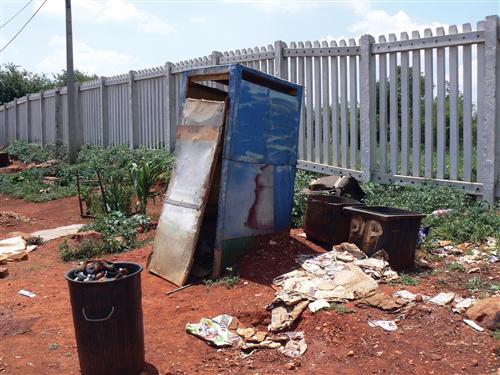The occurence of microbiological organisms and pathogens in drinking water is very much linked to the issues of insufficient sanitation and inefficient water treatment. This is a big problem in many regions of southern Africa. Water borne diseases such as dysentery, cholera, typhoid, gastro-enteritis and hepatitis are, therefore, primary causes of disease in the SADC region.
Insufficient sanitation and water treatment
The problem is especially visible in the densely populated Vaal River basin. In many of the (partly informal) settlements here, sanitation facilities are often crude. Many pit latrines remain unemptied for long periods and are often nothing more than holes in the ground, covered with a sheet of metal. Also, garbage collection does not function well in many communities. Citizens of poorer settlements also complain that, at times, their drinking water supply is contaminated – due to lack of maintenance of the pipe system and/or vandalism. These problems (and a perceived insufficient response by municipal authorities) have caused a lot of protest in the very recent past. There are reports that due to poor service-delivery, many people there have resorted to throwing their waste into the nearest river, which means it interferes with water purification and treatment systems downstream.
Many experts are worried that a lot of South Africa’s sewage and waste water treatment plants are undersized, overloaded, out-dated or simply not working. Many municipalities lack spare parts and chemical supplies for water treatment, because their budget for water and waste water treatment is often too small or is spent elsewhere. They also lack qualified personnel, because in the past 20 years, many good artisans, chemists and engineers have emigrated or moved into the private sector. According to a study by the Water Research Commission (WRC) of South Africa, a parastatal institution based in Pretoria, about 80 percent of water utility employees are not adequately qualified.
Experts in South Africa’s Department of Water Affairs acknowledge that some municipalities achieve amazing things under these conditions. But in many places an alarming lack of commitment and diligent use of public funds result in poor or entirely absent service delivery for water, waste and sanitation.
As a result, many of the waters around Gauteng have thus become breeding grounds for a plethora of bacteria that can cause serious diseases such as diarrhoea, typhoid, cholera and hepatitis. These diseases pose a significant threat to human health, especially the poorest of the poor, who are forced to draw their drinking water directly from rivers, dams or contaminated wells. According to media reports, South Africa experienced 7 000 (reported) cases of cholera in 2008. An interesting situation, when one considers that South Africa is considered a middle-income country by the World Bank(UNESCO 2008).

A pit-latrine in Orange Farm township, to the south of Johannesburg, South Africa.
Source:Kruchem 2008
( click to enlarge )
Box: Microbiological Water Quality in the Basin
Faecal coliform data was assessed by comparing the concentrations found with the guidelines for swimming. This allowed us to assess the water as:
• Poor - Likely to cause diarrhea with full contact swimming.
• Tolerable - May cause diarrhea with full contact swimming.
- Good - Unlikely to cause diarrhea with full contact swimming.
Most of the samples taken in Johannesburg and the surrounding urban areas fall in the 'poor' range - indicating high risks associated with swimming. Further downstream concentrations decrease to tolerable levels. However, high concentrations of faecal bacteria are found in the Vaal River at Parys. Further downstream in the Vaal River bacterial quality falls in the 'Good' range.
Samples taken downstream of the Secunda industrial complex are mostly in the 'Tolerable' range, while concentrations in the rivers flowing into the Katse and Mohale Dams in the Lesotho Highlands are in the 'Good' range. Concentrations at the Upington Water Treatment Works are in the 'Good' range.
Microbiological risks therefore seem to be localised, and associated with the large urban areas in South Africa.
To access an overview of the water quality situation in the Orange-Senqu River basin, please consultant the: "The State of the Orange Senqu River system – A Report on ORASECOM‘s First Joint Basin Survey JBS-1, Centurion 2011", in the Document Library.
